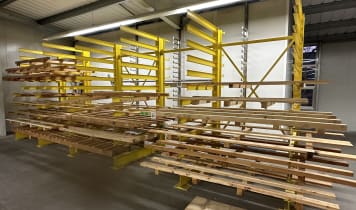The cantilever rack is a type of storage shelf. It is characterised by only having connection elements on the reverse side which are attached perpendicularly. To the front, the cantilever rack is accessible horizontally and access is only restricted by the shelves placed upon them. There are a few key features of cantilever rack design that any operator will need to know.
Cantilever rack structure and individual components
(click to zoom)
Cantilever racks and the lever principle
For regular shelving systems, such as pallet racks, the shelve bottoms rest on at least four support points, which lead the pressure forces downwards onto the floor. While being easy to assemble, standard shelving is prone to toppling sideways, which is why appropriate reinforcement is needed, i.e. diagonal bars, sturdy angular brackets or back walls across the entire reverse side.
Cantilever racking does not feature vertical posts on the front side. This places double the amount of stress on the sections of the reinforcement bar on which the shelves are resting: the forces on the reverse side of the shelf are fed downwards, as usual, into the ground.
On the front side, however, the forces of pressure work in the opposite way: they create a torsional load which turns the reinforcement bars into very effective levers. The wider the shelve bottoms, the strong the lever effect. In terms of statics, cantilever racks are thus subject to very particular requirements.
Cantilever rack statics
Since the cantilever arm within the racking system is only attached to a supporting structure on the reverse side, the vertical retaining elements (and the entire system) must be designed in an especially robust way. This is where sturdy pipe or crate sections come into play, made from highly resilient steel. In the case of light-duty cantilever racks, the reinforcement bars are manufactured from triangularly cut sheet metal. These bars are at their widest where they meet the upright retaining rod, and are narrowest on the front side.
A common application for cantilever shelving is as a wall-supported storage system. Once attached to a stable structural wall, the rack becomes able to handle very heavy loads with ease.
On the other hand, if there is sufficient space, free-standing cantilever shelves can also pull their weight by featuring a double design where the cantilever arms are attached on both sides to provide good stability and prevent the risk of toppling. This design, however, is more suited to light- mid-weight shelving, such as office cantilever racks made from wood. If they are going to be filled using floor conveyors/forklifts, there should be sufficient anchoring to the floor.








